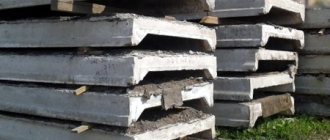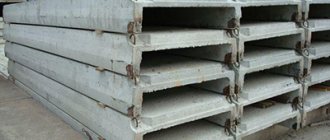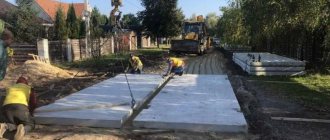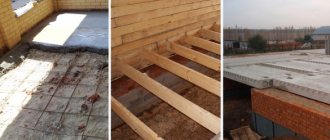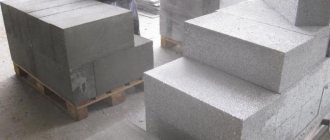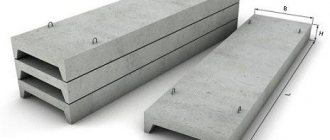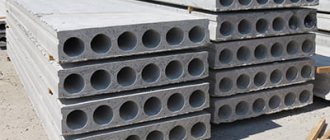Precast concrete products are widely used in various fields of construction, as well as in the construction of roads, access routes to objects for various purposes, runways and other related infrastructure. Ours produces almost all types of road slabs , which are provided for by GOST and are used by construction and operating companies for laying roads and sites.
The construction of a road surface made of reinforced concrete slabs provides the following advantages:
- high speed of track construction;
- minimal preparatory work, especially for the construction of temporary roads;
- the possibility of dismantling the slabs and reusing them;
- high load capacity;
- low distributed pressure on the ground;
- durability even with frequent freeze-thaw cycles.
Road slabs of any type and size are manufactured by vibration pressing in standard molds of a given standard size and reinforced with reinforcement. Based on the purpose of the slab and its load-bearing load, the reinforcement can be installed with pre-tensioning.
No. 1. Road slab production process
Today, road slabs are understood as flat reinforced concrete products with a thickness of 120-240 mm, which can absorb and evenly distribute large loads, which is why even airfield sites are used with their help. The first road slabs were used at the beginning of the twentieth century. This was an experiment in which they wanted to compare the strength of ordinary asphalt and concrete slabs. The experiment lasted several decades, since it was also necessary to compare the durability of the coatings. It turned out that the asphalt needed replacing after 10 years, and every 3-4 years it had to be repaired. The concrete slabs lasted about 40 years without serious deformation and won this competition.
What is the secret of such record durability of concrete slabs and their high strength? You need to look for the answer to this question by studying the features of the production of road slabs:
- the basis of any slab is heavy concrete grade M350 and higher . The frost resistance and water resistance parameters of concrete may vary; the choice of these characteristics depends on the climate of the region where the slabs will be used. Be that as it may, concrete with a frost resistance of less than 100 cycles is not used in production;
- To make the slab stronger, granite filler or crushed limestone is added to the concrete; air-entraining additives can be used. Slabs with granite filling are characterized by maximum durability;
- the heart of the slab, or rather its frame, is the reinforcement . It can be unstressed or prestressed. The second option allows us to produce more durable products that can withstand heavy loads. To create a non-stressed frame, reinforcement of grades A-1, A-3, A-3s, as well as wire type VR-1 (diameter 6-8 mm) are used. For a stressed frame, reinforcement A-5, AT-4 and AT-5 is used;
- the slabs are made using special molds ; two reinforcing meshes are installed in them, which are fixed at a certain distance from each other. The walls of the mold are treated with lubricant to facilitate removal of formwork. When the form is ready and the frame is installed, concrete is poured. To ensure that it is evenly distributed and fills all voids, compaction is carried out using vibration installations. After this, the mold is sent to a heat chamber for 8-12 hours, where the product is exposed to hot steam. When the mixture has hardened, stripping and marking are carried out;
- the finished slabs are stored on a flat base, wooden spacers are used between the rows;
- To facilitate installation, the slabs are equipped with metal mounting loops. After installation, the hinges will not protrude above the road surface. Less often, instead of loops, grooves or holes are made for a collet grip.
All concrete slabs are characterized by fairly high frost resistance, strength, resistance to precipitation and mechanical damage, and high durability. The maximum load depends on the type of concrete used in production.
Design features of products
The design of the slabs makes it possible to form a solid road surface from elements of different sizes.
Road slabs must be flat, they are based on concrete reinforced with steel elements
Reinforced concrete slabs for road construction are distinguished by the following design aspects:
- configuration. Products can have the shape of a rectangle, trapezoid or hexagon, and can also be composed of these shapes from individual segments. If necessary, a hole can be made to install the hatch cover, special brackets or grooves can be made to facilitate installation;
- cleanliness of the working surface. The regulatory document provides for the possibility of manufacturing products with varying degrees of roughness. Available with a smooth or rough surface, as well as with special corrugation to provide improved grip;
- load capacity. It changes with different diameters, brands and degrees of tension of the reinforcement used to manufacture the load-bearing frame. Products can absorb different loads per unit of working surface area. The maximum force value is 30 tons;
- sizes. Depending on the brand of road slabs used, the maximum length can be 6 m and the width 3.5 m. At the same time, the height of the products for various types of products can reach 20 cm. Accordingly, the dimensions for tram and airfield slabs also differ.
Products may also differ in the design of the technological lugs, the reinforcement used, which can be prestressed, as well as the brand of concrete used in the manufacture.
No. 2. Pros and cons of road slabs
Road slabs are quite popular due to many advantages:
- ease of installation and high speed of installation. The finished road surface from slabs can be obtained much faster than with classical asphalt paving technology;
- relatively low cost of road slabs. Work on the construction of this type of road surface is also cheaper due to the absence of the need to carry out excavation of the soil and other related work;
- concrete road slabs can withstand significant loads;
- durability of reinforced concrete slabs;
- resistance of slabs to temperature fluctuations, frost, moisture, vibrations, ultraviolet radiation and other negative factors;
- the ability to reuse slabs, which is especially convenient when organizing access to a construction site. After construction on one site is completed, the slabs can be dismantled and laid on a new site. Outwardly, they are unlikely to look like new, but their technical characteristics will remain at the same level. This trick allows you to save a lot of money when organizing the road surface at a construction site.
The downside that can be noted is the presence of seams, but for temporary roads this is not such a significant drawback, and permanent roads can be covered with asphalt. An alternative option is to seal the joints with mortars.
The main thing when constructing a road surface from ready-made slabs is the quality of the material. Its guarantee may be the name of the manufacturer. In Moscow and the Moscow region, reinforced concrete slabs for road work are offered by the company, which produces products in accordance with GOST standards and conducts constant quality control. High production capacity allows us to fulfill the largest orders in the shortest possible time, and our own fleet of vehicles allows us to quickly deliver products. Cooperation directly with the factory is a guarantee of not only quality, but also a favorable price, since it is possible to do without intermediaries.
Factory production technology
To manufacture concrete products with strict geometric shapes, it is necessary to construct formwork. In enterprises, forms are an alternative. Before use, the workpieces undergo cleaning and treatment of the internal space with a composition that does not have adhesive properties to concrete and metal.
The next sequence of actions is as follows:
- a reinforcing frame is assembled or steel rods are tensioned;
- a mixture of fine crushed stone, sand, cement, water and plasticizers is prepared if necessary;
- the concrete solution is poured into a container and compacted using a vibrating table;
- the mold is sent to the heating chamber to treat future slabs with hot steam for 8-12 hours;
- After cooling, stripping is carried out.
The final stage is checking reinforced concrete slabs for quality and compliance of products with state standards. Before storage, the products are marked regarding their purpose, dimensions and composition. Stacking is accompanied by a layer of wooden beams.
No. 3. Where are road slabs used?
Precast concrete slabs are produced in different sizes and shapes, different thicknesses, with different types of reinforcement and using different grades of concrete. It is easy to guess that the scope of application will be quite wide. Here are the main industries where concrete road slabs are used:
- for the construction of permanent roads for intracity and intercity purposes. The slabs can be used even in northern regions, as they tolerate temperatures down to -400C, and some types even lower;
- for building temporary roads leading, for example, to a construction site, a quarry, etc.;
- for the arrangement of taxiways and airfield runways;
- airfield slabs are also used as a base for heavy structures made of reinforced concrete and metal;
- for repairing worn-out asphalt pavement;
- for the construction of tram tracks;
- for reuse in the construction of temporary roads, since the slabs are not only quickly laid, but also quickly dismantled;
- in private construction, reinforced concrete slabs can be used to organize the area around the house, when creating an entrance to the building, pedestrian paths, etc.;
- There are also non-standard options for using road slabs. Sometimes they are used to organize fencing for industrial enterprises.
Moreover, for private construction, piece slabs are produced that do not have a boring gray and smooth surface, but colored and corrugated . The embossed surface has a positive effect on the anti-slip properties of the plate. On sale you can find slabs of hexagonal, triangular, rhombic and polygonal shapes. As a result, you can get a fairly original design of the site, and if you combine slabs with paving stones or gravel, the result will be very impressive.
Road slabs are becoming more and more versatile, because they are applicable not only in industry and large-scale construction, but also in private construction work.
Technology for constructing public roads
The construction of the roadway begins with the preparation of the base. It should be smooth and durable. To construct a temporary covering, it is enough to make a compacted embankment of sand. In this case, installing a curb is not necessary.
For tracks subject to constant operation, the requirements are more stringent. The road construction activity includes removing the top layer of soil and digging a pit 25-30 cm deep. The base is prepared from several layers with compaction of loose components:
- drainage made of crushed stone (⅔);
- geotextile vegetation barrier;
- sand cushion (⅓).
Gaps and recesses for mounting loops are filled with cement mortar to increase the strength of the road surface. This action also minimizes the movement of plates in the plane direction. To level the surface, you can arrange a continuous asphalt covering or concrete screed.
Stone curbs must be installed along the edges of the road surface. To drain rainwater from the plane between the fencing elements, technological openings 5-7 cm wide are formed. Continuous spans are 8-10 m.
No. 4. Types of plates, markings and sizes
The production of reinforced concrete road slabs is regulated by GOST 21924.0-84 . The same document divides all manufactured slabs into three types:
- PDP are universal road slabs that are suitable for the construction of temporary and unloaded permanent roads. Withstand loads from 10 to 30 tons, tolerate frosts down to -500C, and can be reused;
- PDN - pre-stressed road slabs, have higher strength, can be used under difficult conditions, for example, in regions with a harsh climate (up to -550C) and on soft soil bases;
- PAG – airfield slabs, there is a separate standard for them, GOST 25912-2015. These are heavy slabs of increased strength that can withstand the load of heavy vehicles and are used for runway construction. The products can withstand loads of up to 75 tons at temperatures down to -350C.
The size and shape of the plates vary widely; products with smooth and corrugated surfaces are produced. The latter option is beneficial from the point of view of better traction with the car's wheels.
The above-mentioned GOST 21924.0-84 also regulates the marking of slabs. It encrypts the purpose, shape and size of the product. An example of marking is 2P 30-18-30 . To understand which slab we are talking about, you need to know the nuances of composing such formulas:
- the first numeric character (1 or 2) indicates the type of coating that can be obtained using such slabs. 1 – these are slabs for permanent roads, 2 – for temporary ones;
- the second symbol (or group of symbols) indicates the shape of the product. P – rectangular slab, PB and PBB – rectangular slabs with one or two combined sides, respectively, PT – trapezoidal slab, PSh, PShD, PPSh, DPSh, PShP – hexagonal slabs and their parts;
- the third part of the formula is written through a dot or dash. In our example, this is 30-18, but 30.18 may be marked. These are numbers indicating the rounded length and width of the slab in decimeters, i.e. 30-18 is a slab 3 m long and 1.75 m wide;
- the last number indicates the maximum permissible load on the slab in tons. In our case it is 30 tons.
The most popular slabs are rectangular, they are easy to connect with each other, and they are universal. Trapezoidal and hexagonal elements are produced in small quantities. For them, only one parameter is indicated in the markings: for trapezoidal (PT) - length, for hexagonal (HS) - the size of one side.
A combined bead in slabs is a small protrusion 15 cm long on the bottom surface. If there is one, it is done on the long side, if there are two, then on two short ones.
Among the additional designations in the marking it is worth noting:
- the letter B at the end means that the plate has grooves for loopless installation or holes for a collet grip;
- for prestressed slabs, after the maximum load value, the class of reinforcing steel . If the slab says 1P60.18-30AV, it means that you have a rectangular slab for permanent roads measuring 6*1.75 m, it can withstand a load of 30 tons and is made using AV type steel.
Separately, it is worth highlighting the marking of PAG airfield slabs in accordance with GOST 25912.1. Their markings indicate the type of slab (PAG), followed by the thickness of the slab in centimeters, then the class of reinforcing steel used (A-IV, A-IVC, At-IV, AV, etc.). Example - PAG-14AV.
GOST R-56600-2015 regulates the marking of PDN type slabs. The designation must include an indication of the type of slab (PDN), its purpose (1 or 2), as well as the thickness in centimeters. Example - 1PDN-14. Another type of marking may also occur, since several GOSTs and technical specifications are currently in force.
The following types of slabs are most often used in road construction:
- 1P 30-18-30 – suitable for the construction of roads for permanent use in regions where the temperature does not fall below -400C;
- 2P 30-18-30 - the same slabs, but for the construction of temporary roads;
- 2P 30-18-10 – slabs for temporary roads with a maximum load of up to 10 tons;
- RDP 3*1.5 N30 - slabs 3 m long and 1.75 m wide, weight 2.2 tons, withstand a load of 30 tons. This is a universal material for the construction of roads of any type;
- PAG-14 is used for airfields and roads with increased load, withstands up to 75 tons.
Road slabs are produced in a greater variety than airfield slabs. You can purchase road slabs 1.5-6 m long and 1.0-3.7 m wide, the height ranges from 12 to 24 cm. Airfield slabs are more standardized, usually produced in 6 m long and 2 m wide, the only difference is thickness, from 14 to 20 cm. PAG 14 slabs can be used for equipping airports designed to receive light aircraft; PAG 18 and PAG 20 slabs are an option for runways where heavy aircraft land.
The marking is applied directly to the slab , or rather to its end. It is important that the inscription is clearly readable and remains visible during storage. It is also important that the manufacturer or brand name, weight of the slab, date of manufacture and quality control stamp are indicated on the end. In addition to markings, there must be signs on the slab indicating the center of gravity and support points for storage.
Marking is applied using a stencil, stamp or marking machine; hand-applied application is allowed. It is important that the paint is moisture-resistant, quick-drying, and dark in color.
Principles of marking pedestrian paths
The minimum width of the pedestrian surface is 80 cm. On an individual basis, the parameter is calculated taking into account that 2 people can freely separate when meeting. The roadway is calculated based on the simultaneous movement of a car and a pedestrian.
A distance of 1.5 m or more is maintained relative to the garden plot so that the root system cannot affect the concrete surface. It is also important to maintain a slight slope for rain and melt water to drain independently. The flow should be directed away from outbuildings and the house.
No. 5. What to consider when purchasing?
Analyze all the factors that will affect the slabs during future use. The main parameters are load and temperature. If there will be heavy traffic on the road, then you need to take slabs that can withstand up to 30 tons or more. If you are constructing an entrance to a private house, you can easily get by with slabs that can withstand a load of up to 10 tons. It is also important to consider the type of pavement being built - permanent or temporary.
The price of road slabs depends on the brand of concrete used, the class of steel, the weight of the reinforcement and the production technology. When it comes to the construction of critical facilities, it is very important to make preliminary calculations and determine the most suitable type of slabs. If it is necessary to build a temporary road or a road with a light load, then it is permissible to use used road slabs. This is a great way to save money. In addition, the slabs are easily dismantled, and the high-quality materials used during production allow them to be used repeatedly.
Used road slabs come in two types:
- the first - the slabs that were located under construction trailers and parking lots, retained their geometry and have an almost perfect appearance;
- second – slabs that have been used for roads with a decent load have visible chips and cracks, which, in principle, do not greatly affect performance.
Dimensions of rectangular reinforced concrete panels
The overall dimensions of road slabs of category P depend on the reinforcement technique used in their manufacture. Products with prestressed reinforcement have:
- thickness (H) – 140 mm;
- length (L) – 6000 mm;
- width (B) – 1750, 1870, 3000, 3500 or 3750 mm.
In the manufacture of reinforced concrete panels, non-stressed reinforcement can also be used. Such slabs, the thickness of which is 160 mm, have a length of 1750 mm and a width of 1500 or 1750 mm. Products with a similar type of reinforcement, having a thickness of 170 mm, have two fixed standard sizes: 3000 × 1750 mm and 3500 × 2750 mm.
No. 6. Features of transporting road slabs
Road slabs are heavy products that require special transportation conditions in order for them to arrive at the installation site safe and sound. All delivery problems are usually dealt with by manufacturing companies, but it does not hurt the buyer to know the general rules for the delivery of such cargo.
Precast concrete slabs are transported by trucks with an open body and a crane. To deliver heavy slabs or large quantities of products, long trucks are used. If it is necessary to transport slabs of non-standard large sizes, then planners, trucks with a large carrying capacity and an elongated body come to the rescue.
It is important that the seller, manufacturer or carrier installs and secures the slabs correctly. Otherwise, the slabs may shift while moving and become damaged. Loading and unloading are carried out smoothly and carefully, and a low speed is selected during delivery.
Features to consider when installing
Requirements for road slabs:
- The thickness of the products should be about 140 mm (or more, but not less).
- Reinforcement of slabs is mandatory.
- The density of concrete from which reinforced concrete concrete is made must be in the range from 2200÷2500 kg/m³, and frost resistance – F150 or F
- The shape of the products can be any (for example, rectangular or square).
On a note! It should be remembered that not all road equipment is universal and can lay reinforced concrete panels of any shape.
- Products with either a corrugated or smooth surface are used. The first type of slabs is preferable, since less ice forms on them, and the grip of the wheels on the road is better.
- If reinforced concrete concrete panels have mounting loops, then they must be located in technological recesses so that after laying the road, the brackets do not interfere with the movement of vehicles.
Brands of road concrete
Road and airfield concrete is characterized by a class of compressive strength, designated by the letter B. The number next to the letter shows what load in MPA the material can withstand without collapsing. The grade (M) of concrete also characterizes the properties; the numbers next to the letter indicate the compressive strength in kgf/m2.
Most often, concrete B20 M250 and road concrete B15 M200 are used for constructing roads. In the manufacture of concrete slabs for the construction of airfield pavements, viaducts and bridges, road concrete grade B30 M400 is used, which is endowed with great strength, frost resistance, durability and wear resistance.
Manufacturing technologies
Road slabs are made in several ways:
- The aggregate-flow method is the simultaneous creation of various reinforced concrete products, mixing using a lifting mechanism, as well as drying in special thermal chambers.
- Bench - mixing occurs between the stands of the mechanism, but the product itself remains motionless. The following types of equipment are also involved in production: lifting mechanisms, steaming chamber, mixers for solution, jacks for tensioning steel rods with prestressed reinforcement, metal containers, vibrating table. Despite the seemingly complex process, this method is suitable for small enterprises.
Manufacturing stages:
- preparation of forms - cleaning of concrete mortar residues, lubrication with a substance that reduces the adhesion of the mortar to the surface of the flask;
- laying of reinforcement, fixing;
- preparing the solution;
- addition of plasticizers;
- compaction;
- heating in an oven to improve performance;
- extraction;
- marking;
- storage
For use in road construction or for landscaping adjacent areas, you can order road slabs from the DorZhBI company. High performance qualities and quick installation make it possible to create road surfaces of any size and pattern. We strictly comply with the terms of the contract and deliver products on time to any region of the Russian Federation. We set low prices, the quality is confirmed by a warranty card.

